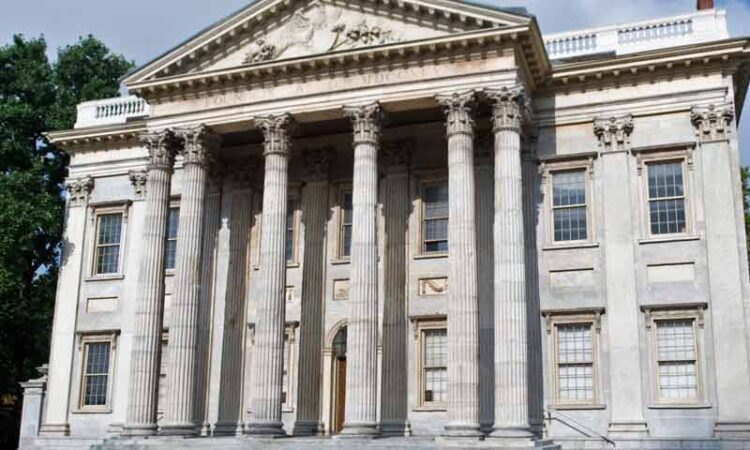
After the Revolutionary War, the United States faced overwhelming debt and an uncertain commercial future. As a response, Secretary of the Treasury Alexander Hamilton stepped forward with a plan to establish a national bank, which would give the federal government more authority to handle the fiscal situation. His proposal incited a heated debate that tested the U.S. Constitution’s boundaries and laid the foundation for the country’s financial system. Located on 3rd Street between Walnut and Chestnut, the First Bank of the United States is currently closed to the public, but its compelling history and stunning exterior continually draw observers from all over the world.
Constitutional Debates
Among the plan’s most vocal opponents was Secretary of State Thomas Jefferson. Jefferson advocated for a strict interpretation of the U.S. Constitution, which didn’t explicitly state that the federal government could create a national bank. On the other hand, Hamilton argued, the Constitution also didn’t prohibit the formation of such a bank. Even after both the House and the Senate approved the bill, Jefferson urged President Washington to veto it. Instead, Washington gave Hamilton a week to address Jefferson’s arguments. Hamilton delivered a 15,000-word rebuttal that swayed Washington.
Bank Business
Congress gave the Bank of the United States, now commonly known as the First Bank, a 20-year charter that started in December 1791. The bank did not dictate fiscal policy, but it still wielded great influence over the country’s finances due to its size. The banknotes issued by the First Bank gave the U.S. the closest thing to a national currency at a time when each state bank could print its own banknotes. First Bank notes were also the only ones accepted when paying federal taxes, which the First Bank was in charge of collecting. It also worked to pay the government’s bills, including much of the debt left over from the Revolutionary War. Congress opted not to renew the bank’s charter when it expired in 1811. Five years later, after the War of 1812, President James Madison signed a bill establishing the Second Bank of the United States.
The Building
When the bank first opened in 1791, it was initially housed in Carpenters’ Hall on Chestnut Street, but it moved into a magnificent new home on South Third Street six years later. Designed by architect Samuel Blodgett, Jr., the new bank headquarters consisted of a three-story brick building with a blue marble façade.
The architecture of the First Bank of the United States communicates strength and reliability with symbols of money and banking. The main entrance door’s arch has a marble keystone with the head of Mercury, ancient Roman god of commerce. The carved marble panel above celebrates the new nation’s firm financial footing: a baby (America) wearing a helmet like Mercury’s leans against a globe (the international economy) that shows “Africa” clearly labeled (the human and mineral riches of that continent) and rests his foot on a beehive (an ancient symbol for industriousness). Next to the globe is a cornucopia (rich harvest) that spills out coins instead of fruit. Behind the baby are tall books (knowledge) that are financial ledgers. Behind the books are sailing ships (maritime wealth) and an American flag.
On the the building’s triangular pediment above the columns, the display of an enormous eagle “seals the deal” as a representation of America’s power and promise. Carved out of mahogany by Claudius LeGrand, the bank’s eagle is the oldest known architectural reference to the Great Seal of the United States.
After the First Bank closed, the building housed Girard Bank, founded by Philadelphia merchant Stephen Girard. After his death in 1831, other corporate banks owned the building. In 1902, bank officials had the building’s interior remodeled. In 1955, the National Park Service procured the First Bank building. Check out these FAQs about the building and its history.
Today, the First Bank is undergoing preservation and is closed to the public, though the exterior remains a popular spot for photo-ops.





